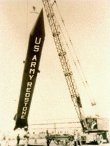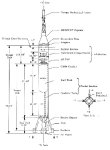|

U.S. Army Redstone.

Mercury-Redstone booster units from Mercury-Redstone Project, December 1964.
|
Redstone Rocket
The Redstone rocket launched the first American satellite into orbit. The rocket was developed by a team headed by Dr. Werhner von Braun, who had been working for the U.S. Army at Fort Bliss, Texas. In 1950, the team was transferred to Redstone Arsenal in Huntsville, Alabama, where the army centered its rocket development activities. The arsenal had been used during World War II to produce various chemical compounds and pyrotechnical devices. Its name referred to the color of the rock and soil in Huntsville.
In Huntsville, the Germans joined a growing cadre of U.S. rocketry specialists in a combined team called the Ordnance Guided Missile Center. It was working on developing missiles to counter Soviet Cold War threats. The most famous missile produced there was officially named "Redstone" on April 8, 1952, in recognition of its development at Redstone Arsenal.
The Redstone was a high-accuracy, liquid-propelled, surface-to-surface missile and was a direct descendant of the German V-2 rocket. The Redstone's liquid-fueled engine burned alcohol and liquid oxygen and produced about 75,000 pounds (333,617 newtons) of thrust. It was nearly 70 feet (21 meters) long and slightly under 6 feet (1.8 meters) in diameter. At burnout, or when the propellant was exhausted, it had a speed of 3,800 miles per hour (6,116 kilometers per hour). For guidance, it used an all-inertial system featuring a gyroscopically stabilized platform, computers, a programmed flight path taped into the rocket before launch, and the activation of the steering mechanism by signals in flight. For control during powered ascent, the Redstone depended on tail fins with movable rudders and refractory carbon vanes mounted in the rocket exhaust.
The first Redstone missile was launched on August 20, 1953, from the military's missile range at Cape Canaveral, Florida, and traveled 8,000 yards (7,315 meters). Thirty-six more models were launched through 1958, 16 of them built by Redstone Arsenal, the rest by Chrysler Corporation, a major American automobile company. On May 16, 1958, combat-ready soldiers made their first firing of a Redstone rocket. It was put into U.S. Army service in Germany that June.
On January 31, 1958, a modified four-stage Redstone rocket, known as Jupiter-C, lifted the first American satellite, Explorer I, into orbit. A Redstone rocket also launched the Mercury capsules on their sub-orbital flights in 1961, inaugurating America's human spaceflight program.
|



